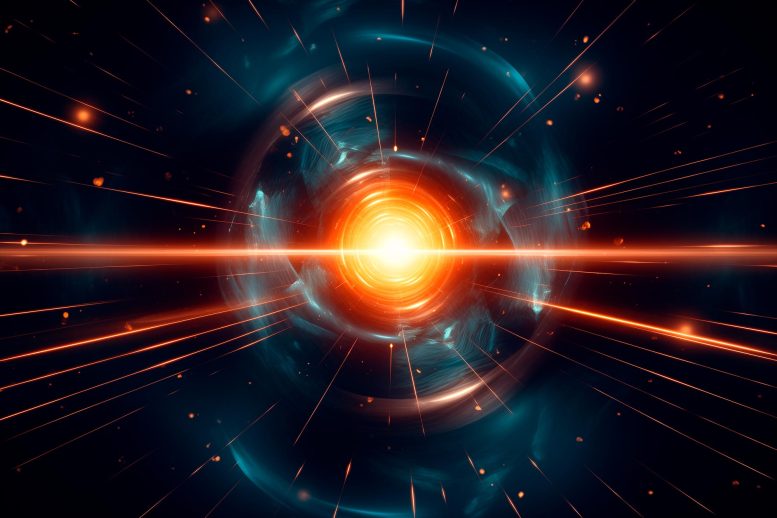
The magnetic moment of the muon has posed a scientific puzzle due to the slight difference between its theoretical and experimental values, suggesting interactions with unknown particles or forces. Research involving advanced quantum simulations has started to unravel these discrepancies, offering insights into the fundamental properties of muons and their interactions in particle physics. Credit: SciTechDaily.com
The researchers identified the origin of discrepancies in recent predictions of the muon’s magnetic moment. Their findings could contribute to the investigation of dark matter and other aspects of the new physics.
Magnetic moment is an intrinsic property of a particle with spin, arising from interaction between the particle and a magnet or other object with a magnetic field. Like mass and electric charge, magnetic moment is one of the fundamental magnitudes of physics. There is a difference between the theoretical value of the magnetic moment of a muon, a particle that belongs to the same class as the electron, and the values obtained in high-energy experiments conducted in particle accelerators.
The difference only appears at the eighth decimal place, but scientists have been intrigued by it since it was discovered in 1948. It is not a detail: it can indicate whether the muon interacts with dark matter particles or other Higgs bosons, or even whether unknown forces are involved in the process.
Discrepancies in Muon’s Magnetic Moment
The theoretical value of the muon’s magnetic moment, represented by the letter g, is given by the Dirac equation – formulated by English physicist and 1933 Nobel Prize winner Paulo Dirac (1902-1984), one of the founders of quantum mechanics and quantum electrodynamics – as 2. However, experiments have shown that g is not exactly 2 and there is a great deal of interest in understanding “g-2”, i.e. the difference between the experimental value and the value predicted by the Dirac equation. The best experimental value currently available, obtained to an impressive degree of precision at the Fermi National Accelerator Laboratory (Fermilab) in the United States and announced in August 2023, is 2.00116592059, with an uncertainty range of plus or minus 0.00000000022.
“Precise determination of the muon’s magnetic moment has become a key issue in particle physics because investigation of this gap between the experimental data and the theoretical prediction can provide information that could lead to the discovery of some spectacular new effect,” physicist Diogo Boito, a professor at the University of São Paulo’s São Carlos Institute of Physics (IFSC-USP), told Agência FAPESP.
An article on the subject by Boito and collaborators is published in the journal Physical Review Letters.
New Insights From Research
“Our results were presented at two important international events. First by me during a workshop in Madrid, Spain, and later by my colleague Maarten Golterman of San Francisco State University at a meeting in Bern, Switzerland,” Boito said.
These results quantify and point to the origin of a discrepancy between the two methods used to make current predictions of muon g-2. “There are currently two methods for determining a fundamental component of g-2. The first is based on experimental data, and the second on computer simulations of quantum chromodynamics, or QCD, the theory that studies strong interactions between quarks. These two methods produce quite different results, which is a major problem. Until it’s solved, we can’t investigate the contributions of possible exotic particles such as new Higgs bosons or dark matter, for example, to g-2,” he explained.
The study succeeded in explaining the discrepancy, but to understand it we need to take a few steps back and start again with a somewhat more detailed description of the muon.
The muon is a particle that belongs to the class of leptons, as does the electron, but has a much larger mass. For this reason, it is unstable and survives only for a very short time in a high-energy context. When muons interact with each other in the presence of a magnetic field, they decay and regroup as a cloud of other particles, such as electrons, positrons, W and Z bosons, Higgs bosons, and photons. In experiments, muons are, therefore, always accompanied by many other virtual particles. Their contributions make the actual magnetic moment measured in experiments greater than the theoretical magnetic moment calculated by the Dirac equation, which is equal to 2.
“To obtain the difference [g-2], it’s necessary to consider all these contributions – both those predicted by QCD [in the Standard Model of particle physics] and others that are smaller but appear in high-precision experimental measurements. We know several of these contributions very well – but not all of them,” Boito said.
The effects of QCD strong interaction cannot be calculated theoretically alone, as in some energy regimes they are impracticable, so there are two possibilities. One has been used for some time and entails resorting to the experimental data obtained from electron-positron collisions, which create other particles made up of quarks. The other is lattice QCD, which became competitive only in the current decade and entails simulating the theoretical process in a supercomputer.
“The main problem with predicting muon g-2 right now is that the result obtained using data from electron-positron collisions doesn’t agree with the total experimental result, while the results based on lattice QCD do. No one was sure why, and our study clarifies part of this puzzle,” Boito said.
He and his colleagues conducted their research exactly to solve this problem. “The article reports the findings of a number of studies in which we developed a novel method to compare the results of lattice QCD simulations with the results based on experimental data. We show that it’s possible to extract from the data contributions that are calculated in the lattice with great precision – the contributions of so-called connected Feynman diagrams,” he said.
American theoretical physicist Richard Feynman (1918-1988) won the 1965 Nobel Prize in Physics (with Julian Schwinger and Shin’ichiro Tomonaga) for fundamental work in quantum electrodynamics and the physics of elementary particles. Feynman diagrams, created in 1948, are graphical representations of the mathematical expressions that describe the interaction of such particles and are used to simplify the respective calculations.
“In the study, we obtained the contributions of connected Feynman diagrams in the so-called ‘intermediate energy window’ with great precision for the first time. Today we have eight results for these contributions, obtained by means of lattice QCD simulations, and all of them agree to a significant extent. Moreover, we show that the results based on electron-positron interaction data don’t agree with these eight results from simulations,” Boito said.
This enabled the researchers to locate the source of the problem and think about possible solutions. “It became clear that if the experimental data for the two-pion channel are underestimated for some reason, this could be the cause of the discrepancy,” he said. Pions are mesons – particles made up of a quark and an antiquark produced in high-energy collisions.
In fact, new data (still being peer-reviewed) from the CMD-3 Experiment conducted at Novosibirsk State University in Russia appears to show that the oldest two-pion channel data may have been underestimated for some reason.
Reference: “Data-Driven Determination of the Light-Quark Connected Component of the Intermediate-Window Contribution to the Muon g−2” by Genessa Benton, Diogo Boito, Maarten Golterman, Alexander Keshavarzi, Kim Maltman and Santiago Peris, 21 December 2023, Physical Review Letters.
DOI: 10.1103/PhysRevLett.131.251803
Boito’s participation in the study was part of his project “Testing the standard model: precision QCD and muon g-2,” for which FAPESP awarded him a Phase 2 Young Investigator Grant.

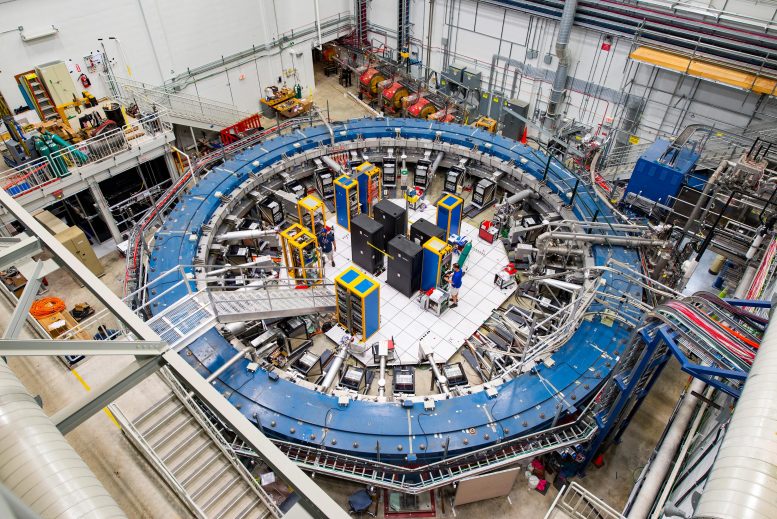

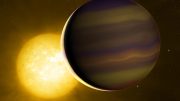


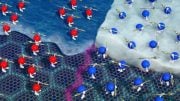


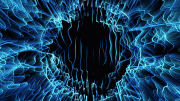
How a Decimal Place Could Redefine Physics? Physics should have a correct understanding of mathematics.The universe does not do algebra, formula or fraction. The universe is geometrythe, and is the superposition, deflection, and twisting of geometric shapes.
Science must eliminate falsehood and preserve truth. The things that researchers can observe in experiments are always superficial phenomena, not essential.
According to topological vortex gravitational field theory, spin creates everything, spin creates the world, spin creates the future. In the interaction of topological vortices, time is both absolute and relative,and physics often requires treating space and time at the same level. Spin generates time, spin generates gravitation, spin generates energy, spin generates evolution. Each topological vortex is a quantum clock. Starting from the formation of topological vortices, precise timing begins.
All observable movements in the physical world are inseparable from the interaction of topological vortices, including human observational behavior itself. The interaction and balance of topological vortices not only demonstrate the beauty of mathematics, but also change the way humanity understand nature. Studying topological vortices can greatly expand the boundaries of humanity cognition.
Today, we have already entered the era of the internet. With the help of artificial intelligence and big data, discussions on scientific knowledge have become open and transparent. However, a group of editors of so-called academic journals (such as Physical Review Letters, Nature, Science, etc.) are self righteous, self proclaimed, fooling the public, lack remorse, and mystifying themselves. They only care about their own so-called sufficiently high priority rating, general significance, discipline, novelty, etc., and do not care about what science and pseudoscience are.
Science and pseudoscience are not determined by a publication, an organization or a person, nor by you or me, but by mathematics the final say. Physical models must be based on mathematics or mathematical models in order to be scientific, convincing, and in accordance with natural laws.
The origin of geometry lies in the concerns of everyday life. The branch of geometry (mathematics) known as topology has become a cornerstone of modern physics. Topological vortex and antivortex are two bidirectional coupled continuous chaotic systems. They exhibit parity conservation, charge conjugation, and time reversal symmetry. The synchronization effect is extremely important in their interactions. The synchronization effect of the superposition, deflection, and twisting of multiple or countless topological vortices will make spacetime motion more complex. To understand this complex world, physics should respect the authenticity of topological vortex in low dimensional spacetime, rather than simply relying on a few formulas, numbers, or imagined particles.
Spin is a natural property of topological vortices. Spin is synchronized with energy, spin is synchronized with gravitation, spin is synchronized with time, spin is synchronized with evolution. The perpetually swirling topological vortices defy traditional physics’ expectations. One physical properties of topological vortices is them to spontaneously begin to change periodically in time, even though the system does not experience corresponding periodic interference. Therefore, in the interaction of topological vortices, time is both absolute and relative,and physics often requires treating space and time at the same level.
Low-dimensional spacetime matter is the foundation of high-dimensional spacetime matter. Low-dimensional spacetime matter (such as topological vortex) can form new material structures and derive more complex physical properties via interactions and self-organization. It is extremely wrong and irresponsible to imagine low dimensional spacetime matter using high-dimensional spacetime matter,such as a cat in quantum mechanics.
Science must follow mathematical rules. For example, the Standard Model (SM) is considered to be one of the most significant achievements of physics in the 20th century. However, the magnetic moment of μ particle is larger than expected, revealed by a g-2 experiment at Fermilab, suggests that the established theory (such as SM) of fundamental particles is incomplete. Furthermore, the SM omitting gravitation, it not involved the time problem and when the particle movement starts. Mathematics is the foundation of science. Physics must respect the scientific nature of mathematics and mathematical models. The SM must be based on mathematical models in order to be scientific, convincing, and in line with natural laws.
I hope researchers are not fooled by the pseudoscientific theories of the Physical Review Letters (PRL), and hope more people dare to stand up and fight against rampant pseudoscience.
The so-called academic journals (such as Physical Review Letters, Nature, Science, etc.) firmly believe that two high-dimensional spacetime objects (such as two sets of cobalt-60) rotating in opposite directions can be transformed into two objects that mirror each other, is a typical case of pseudoscience rampant.
If researchers are really interested in Science and Physics, you can browse https://zhuanlan.zhihu.com/p/643404671 and https://zhuanlan.zhihu.com/p/595280873.
The Physical Review Letters (PRL) is the most evil, ugly, and dirty publication in the history of science. Nature and Science have been influenced by Physical Review Letters (PRL) and are even more notorious. The behavior of these pseudo-academic publications has seriously hindered the progress and development of human society in science and technology.
I am well aware that my relentless repetition can make some people unhappy, but in the fight against rampant pseudoscience, that’s all I can do.
(0.001165920+((61-41)+(57-25))*10^-9/2)[experiment data] – (0.00116584719+6845*10^-7+154*10^-8+92*10^-9)[theoretical prediction]=0.00116592026-0.00116591810=2.16*10^-9=(me/pm)^2/137.036=1/(1836.1527^2*137.036)=128.4980143*A/3.1415926=2pi*0.001161409725*(me/pm)^2, 0.001161409725=1/(2pi*137.036) : Schwinger’s weak QED for anomalous electron magnetic moment of (g-2)/2 factor from potential energy of positron e+=ch/(2pi*137.036) oscillating with momentum energy of electron e-=me*(c/137.036)^2*A in Dirac’s quantum field, pm/me=1836.1527=4pi*137.036^2/128.51991=1/(4*A1*137.036^3)=(pi/(128.4980143*A*137.036))^0.5 : ratio between proton[pm=1.672621868*10^-27 kg], electron[me=9.10938356 kg] which’s weak force unite strong force g(p)=g*m^2/pm^2=g*(pl/4.1888*l)^2=1.13*10^28 which’s by graviton g*m^2=ch/(2pi) : solution of GR field equation ch=8pi*g*(m*c^2/2)^2/c^4 oscillating between quantum black hole at Planck scale l=g*m/c^2=(h*g/2pi*c^3)^0.5 which can deduce ch=2pi*g*m^2, EM force k*e^2=g(p)*pm^2/137.036=ch/(2pi*137.036)=me*(c/137.036)^2*A=4pi*g(p)*pm*me*137.036/128.51991 which can turn into quantum gravity ch=2pi*k*e^2*137.036=(2*A1*137.036*pm*c^2)*(4pi*A*137.036)=En*L produce photon at Atom scale A^2=g(p)*pi*me/128.4980143*c^2 by r=En=ch/L=chR=me*(c/137.036)^2/2=13.6*e[1.602*10^-19], from it can deduce 80.42939 Gev[80.4335+,-0.0094] : W boson from theoretical prediction 80.351 Gev[+0.006], 85.73% ratio between muon[105 mev=(3*137.036/2)*0.511], electron[0.511 mev=me*c^2=g*m^2*137.036/A] decay from strong force by 14.27=A/(3*137.036*(A-A1))=128.51991/(3*137.036*(128.51991-128.49801421207))=128.49801421207/3^2=(80.351+0.135)/(137.036*(80.486-(80.42939+0.015448))) where A1=A*(128.4980143/128.51991)=5.2908712*10^-11 meter, weak force which we know cause all 3 anomalies should be not extra force , or particle cause discrepancy of muon magnetic moment. (0.015448 Gev[1.602/c^2]=g*m^2/137.036*8.38=k*e^2/(8pi/3) : Tau neutrino, 135 mev=15.448/(1/3)^2+0.511+0.1811/6-4.552 : pion, 0.1811 mev=pm^2/(2*g*m^2*137.036)=1/(2*g(p)*137.036) : Muon neutrino, 8pi*0.1811=4.552 mev : down quark)
Thank you for your hard work. However, you should have a correct understanding about mathematics. The universe does not do algebra, formula or fraction. The universe is geometrythe, and is the superposition, deflection, and twisting of geometric shapes.
According to topological vortex gravitational field theory, vortices (matter) and antivortices (antimatter) are formed simultaneously, with the same geometric shape but opposite directions of rotation. Countless topological vortices make spacetime motion more complex via the synchronous effects of superposition, deflection, and twisting. Therefore, there is so much data coming in from the LHC, the most powerful accelerator in the world, that recording it all has never been an option.
The rotation of topological vortices is spin. Spin creates everything, spin creates the world, spin creates the future. In the interaction of topological vortices, time is both absolute and relative,and physics often requires treating space and time at the same level.
Spin occupies space, spin generates time, spin generates gravitation, spin generates energy, spin generates evolution. Each topological vortex is a quantum clock. Starting from the formation of topological vortices, precise timing begins.
Science must follow mathematical rules. For example, the Standard Model (SM) is considered to be one of the most significant achievements of physics in the 20th century. However, the magnetic moment of μ particle is larger than expected, revealed by a g-2 experiment at Fermilab, suggests that the established theory (such as SM) of fundamental particles is incomplete. Furthermore, the SM omitting gravitation, it not involved the time problem and when the particle movement starts. Mathematics is the foundation of science. Physics must respect the scientific nature of mathematics and mathematical models. The SM must be based on mathematical models in order to be scientific, convincing, and in line with natural laws.
All observable movements in the physical world are inseparable from the interaction of topological vortices, including human observational behavior itself.
The perpetually swirling topological vortices defy traditional physics’ expectations. The interaction and balance of topological vortices not only demonstrate the beauty of mathematics, but also change the way humanity understand nature. Studying topological vortices can greatly expand the boundaries of humanity cognition.
If you are really interested in science and physics, you can browse the comments in the https://scitechdaily.com/microscope-spacecrafts-most-precise-test-of-key-component-of-the-theory-of-general-relativity/.